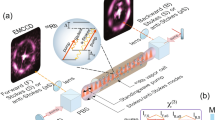Abstract
Sum-frequency generation by incoherent nonlinear optical mixing of one coherent and one chaotic, mutually uncorrelated input radiations in a dispersive medium is treated in this paper. The efficiency of the process is calculated in the second approximation of the iterative method. It is shown that for perfect phase matching or small phase mismatch of interacting waves and small spectral width of chaotic input radiation the efficiency of incoherent sum-frequency generation can be enhanced compared with the coherent interaction due to the difference between group velocities of sub-frequency radiations. On the other hand, for greater spectral width the efficiency of the process decreases with increasing spectral width of chaotic input radiation. In the case of considerable phase mismatch the efficiency of sum-frequency generation first decreases, but then increases with increasing spectral width of chaotic input radiation. The spectral distribution of the resulting sum-frequency radiation is calculated in the first approximation of the iterative method. There is a general tendency to narrowing the spectral distribution of generated radiation in the course of the process. Moreover, when there is phase mismatch present, a spectral shift of the maximum of generated radiation towards blue or red region, according to the signs of the phase mismatch and the typical dispersion coefficient, appears in the later phases of the sum-frequency generation.
Similar content being viewed by others
References
Chmela P., Ficek Z., Kielich S.: Czech. J. Phys. B39 (1989) 509.
Zernike F., Midwinter J. E.: Applied Nonlinear Optics. Wiley, New York, 1973.
Stepanov D. Yu., Shigorin V. D., Shipulo G. P.: Kvantovaya Elektron. (Moskva)11 (1984) 1957.
Chmela P.: Wprowadzenie do optyki neiliniowej. Państwowe Wydawnictwo Naukowe, Warsaw, 1987.
Szivessy G.: Kristalloptik, Handbuch der Physik, B. XX. Springer, Berlin, 1928.
Sommerfeld A.: Optik. Akademische Verlagsgesellschaft Geest & Portig K.-G., Leipzig, 1959.
Chmela P.: Opt. Quant. Electron.14 (1982) 425, 433.
Chmela P.: Czech. J. Phys. B38 (1988) 283.
Chmela P., Ficek Z., Kielich S.: Opt. Commun.62 (1987) 403.
Loudon R.: The Quantum Theory of Light. Clarendon Press, London, 1981.
Author information
Authors and Affiliations
Additional information
This work was partially supported by Research Project C.P.B.P. 01. 07.
Rights and permissions
About this article
Cite this article
Chmela, P., Ficek, Z. & Kielich, S. Classical theory of non-degenerate sum-frequency generation by incoherent nonlinear optical mixing of coherent and chaotic radiations II. Coherent and chaotic input radiations — Efficiency and spectral distribution. Czech J Phys 39, 642–658 (1989). https://doi.org/10.1007/BF01597906
Received:
Issue Date:
DOI: https://doi.org/10.1007/BF01597906




